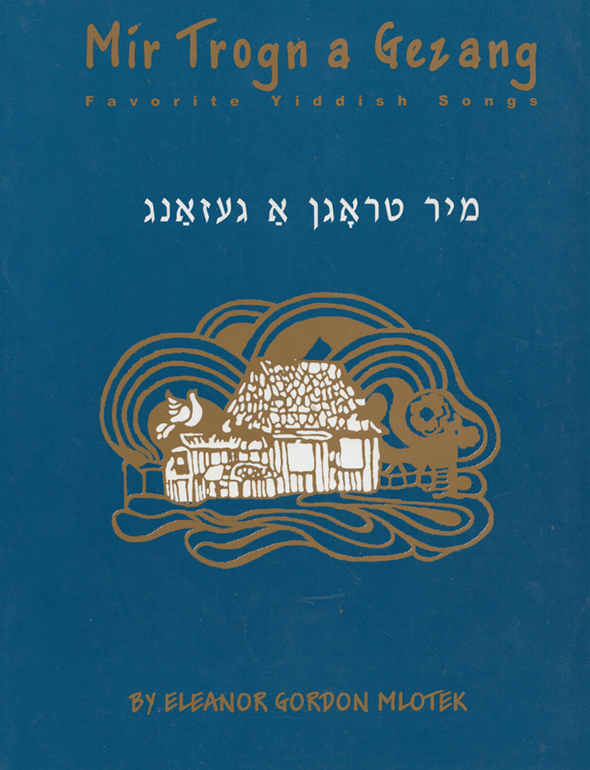Folk Song, published in 1918 by M. Kipnis. A favorite in the repertoire of many cantors.

A cantor arrives in a small town
to daven (sing the prayers) on Shabes, to daven on Shabes.
To hear him, there come
the three finest little citizens of the town,
the three finest citizens of the town.
One is a little tailor, the second a little blacksmith,
and the third one a little coachman.
The little tailor calls out,
the little tailor calls out:
“Oh boy, did he daven! How he davened!
Like when you make a stitch with the needle,
a press with the iron.
Oh, is this a cantor!
Oy-oy-oy-oy-oy-oy-oy –
Oh boy, did he daven!
The little blacksmith calls out,
the little blacksmith calls out:
“Oh boy, did he daven! How he davened!
Like when you give a bang with a hammer,
and a squeeze with the tongs,
Oh, is this a cantor!
Oy-oy-oy-oy-oy-oy-oy –
Oh boy, did he daven!
The little coachman calls out,
the little coachman calls out:
“Oh boy, did he daven! How he davened!
Like when you give a yank on the reins,
an a crack with the whip – giddyap!
Oh, is this a cantor!
Oy-oy-oy-oy-oy-oy-oy –
Oh boy, did he daven!
lz gekumen a khazn in a kleyn shtetl
Davenen a shabes, davenen a shabes.
Zaynen im gekumen hern
Di dray shenste balebatimlekh fun shtetl,
Di dray shenste balebatim fun shtetl.
Eyner a shnayderl, der tsveyter a kovaltshikl,
Un der driter a balegoltshikl.
Ruft zikh opet dos shnayderl,
Ruft zikh opet dos shnayderl:
— Oy, hot er gedavnt! hot er gedavnt!
Azoy vi men git mitn nodl a shtokh,
Mitn ayzn a pres.
Oy, iz dos a khazn!
Oy-oy-oy-oy-oy-oy-oy –
Hot er gedavnt!
Ruft zikh opet dos kovaltshikl,
Ruft zikh opet dos kovaltshikl:
— Oy, hot er gedavnt! hot er gedavnt!
Azoy vi men git mitn hamer a zets
Un mit di kleshtshes a kvetsh,
Oy, iz dos a khazn!
Oy-oy-oy-oy-oy-oy-oy —
Hot er gedavnt!
Ruft zikh opet dos balegoltshikl,
Ruft zikh opet dos balegoltshikl:
— Oy, hot er gedavnt! hot er gedavnt!
Azoy vi men git mit di leytses a tsi,
Un mitn baytshl a khvoshtsh — vyo!
Oy, iz dos a khazn!
Oy-oy-oy-oy-oy-oy-oy —
Hot er gedavnt!
איז געקומען א חזן אין אַ קלײן שטעטל,
דאַװענען אַ שבת, דאַוענען א שבת.
זײַנען אים געקומען הערן
די דרײַ שענסטע בעלי-בתּימלעך פֿון שטעטל,
די דרײַ שענסטע בעלי-בתּימלעך פֿון שטעטל.
אײנער אַ שנײַדערל, דער צװײטער אַ קאָװאַלטשיקל,
און דער דריטער א באַלעגאָלטשיקל,
רופֿט זיך אָפּעט דאָס שנײַדערל,
רופֿט זיך אָפּעט דאָס שנײַדערל:
— אױ, האָט ער געדאװנט! האָט ער געדאַװנט!
אַזױ װי מען גיט מיטן נאַדל א שטאָך,
מיטן אײַזן א פּרעס,
אױ, איז דאָס אַ חזן!
אױ-אױ-אױ-אױ-אױ-אױ–אױ —
האָט ער געדאַװנט!
רופֿט זיך אָפּעט דאָס קאָװאַלטשיקל,
רופֿט זיך אָפּעט דאָס קאָװאַלטשיקל:
—- אױ, האָט ער געדאַװונט! האָט ער געדאַװנט!
אַזױ װי מען גיט מיטן האַמער א זעץ,
און מיט די קלעשטשעס אַ קװעטש,
אױ, איז דאָס אַ חזן,
אױ-אױ-אױ-אױ-אױ-אױ-אױ —
האָט עֶר געדאַװנט!
רופֿט זיך אָפּעט דאָס באַלעגאָלטשיקל,
רופֿט זיך אָפּעט דאָס באַלעגאָלטשיקל:
— אױ, האָט ער געדאַװנט! האָט ער געדאַװנט!
אַזױ װי מען גיט מיט די לײצעס אַ צי,
און מיטן בײַטשל אַ כװאַשטש — װיאָ!
אױ, איז דאָס אַ חזן!
אױ-אױ-אױ-אױ–אױ-אױ-אױ. —
האָט ער געדאַװנט!
Song Title: A Khazndl Oyf Shabes

First published in 1972, Mir Trogn A Gezang: Favorite Yiddish Songs was reprinted six more times (in 1977, 1982, 1985, 1987, 1988, 2000) due to popular demand. The songs in this anthology represent a sampling of beloved folk and well-known Yiddish songs, many of which are scattered in various song collections; some appear in very rare and inaccessible collections; and some were never before published. Folk songs comprise about a third of this volume and were selected mainly on the basis of popularity and sometimes for their historic significance. Needless to say, they are only representative of the vast, rich treasure of Yiddish folk material. The selection was made not only on the basis of personal preference, but in the knowledge they are favorites of many who sing these songs. Most of the songs represent the repertoire that was sung at Yiddish summer camps, May 1st demonstrations and at social gatherings. Many songs were introduced to American Jewry by Jewish immigrants who came to the United States after World War II, for whom these songs had been favorites in Poland and other East European communities destroyed by the Nazis.